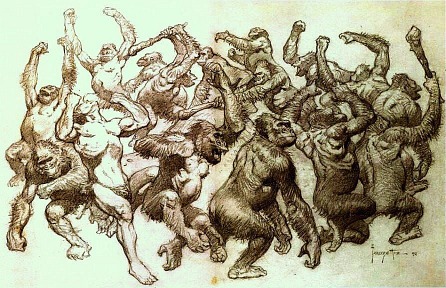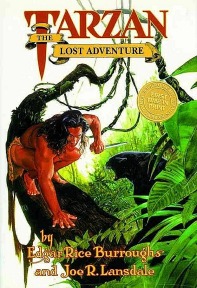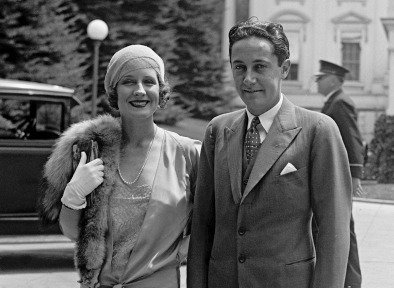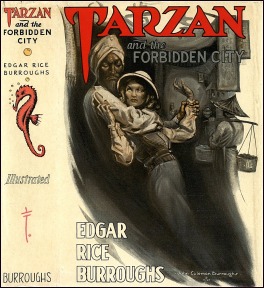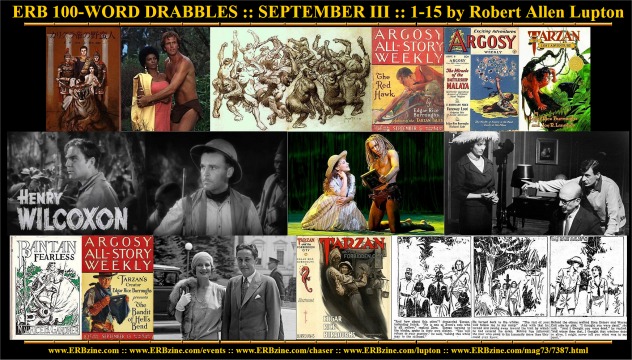
Official Edgar Rice Burroughs Tribute and Weekly Webzine Site Since 1996 ~ Over 15,000 Webpages in Archive Volume 7387 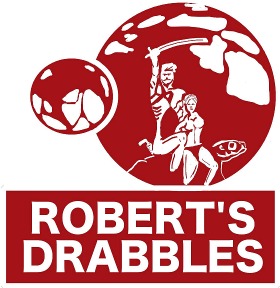 |
ERB 100-Word Drabbles
SEPTEMBER III Edition :: Days 1 - 15
See Days 16 - 30 at ERBzine 7387a
by Robert Allen Lupton
With Collations, Web Page Layout and ERBzine Illustrations and References by Bill Hillman
FONT OF KNOWLEDGE
September 1: On this day in 1875, Edgar Rice Burroughs was born in Chicago, Illinois. Burroughs and ERB Inc. celebrated his birthday over the years by publishing a number of ERB’s books on that day, including "Tarzan Triumphant" in 1932; "Tarzan and the City of Gold," 1933; "Tarzan and the Lion Man," 1934, and "Tarzan's Quest," 1936, and “I Am A Barbarian,” 1967.
Wish Ed a happy birthday and lift a glass to the hours of enjoyment he’s given us all. Be it wine, ale, whiskey, water, or soda, hold it high. As long as people read his books, one of his quotes always rings true, “I Still Live.”
‘I am A Barbarian was published on September 1, 1967 by ERB Inc. The book, with a Jeff Jones cover, was limited to 2000 copies. According to Jim Goodwin’s “Edgar Rice Burroughs: The Descriptive Bibliography of The Ace and Ballantine/del Rey Paperback Books,” Ace Books published a paperback version with a Boris Vallejo cover in 1975. Counting the first paperback publication, Ace published 9 variants of the book over the next few years.
Details about “I Am A Barbarian” are located at: https://www.erbzine.com/mag8/0863.html
The drabble for today is “Font of Knowledge,” at is was somewhat inspired by “I Am A Barbarian.”
FONT OF KNOWLEDGE
![]()
Agrippina, the mother of Emperor Caligula replied, “Ridiculous! Who told you such nonsense? Time to take off your little boots, put on your big boy shoes, and be the ruler.”
“I have it on good authority from my slave, Britannicus.
He’s the smartest man alive.”
“A slave, smart? Can’t be true.”
“Mother, his full name is Encyclopedius Britannicus!”
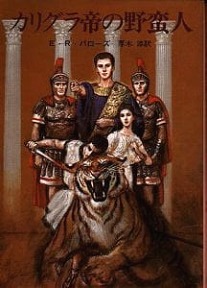
September 2: On this day in 1973, the Tarzan film, “Tarzan’s Deadly Silence,” was released in Finland. The film combined two television episodes of the Ron Ely Tarzan series into an 88 minute film. Details about the film may be found at: https://www.erbzine.com/mag74/7420.html
Former Tarzan, Jock Mahoney, played the villain, known only as the Colonel. Woody Strode, who had appeared in “Tarzan’s Fight for Life,” and “Tarzan’s Three Challenges, “played Marshak, and Nichelle Nichols, whom we all know as Nyota Uhura in Star Trek the original series, played Ruana.
The drabble for today is “Quiet Time.”
QUIET TIME
![]()
Tarzan said, “Can’t hear you.”
She yelled.
“Thanks for shouting. Not helpful, I’m deaf."
Ruana repeated herself, speaking very slowly.
Tarzan said, “I’m deaf, speaking slowly means it takes
longer for me not to understand.”
Ruana tried sign language until Tarzan finally understood.
“The Colonel wants the ivory from the elephant’s graveyard. Remember if
we get caught, I’m deaf. You don’t speak English.”
“But you’re deaf. I don’t speak English.”
“Huh?”
“Never mind.”
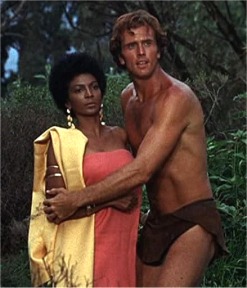
THERE HAS TO BE A BAD GUY!
September 3: On this day in 1933, the adaption of “Tarzan the Invincible” illustrated b Rex Maxon and written by R. W. Palmer concluded. The story adaption began on March 27, 1933. It would be followed by the adaption of “Tarzan and the City of Gold.”
The strip may be read in its entirety at: https://www.erbzine.com/mag32/3273.html
The drabble for today, “There Has To Be a Bad Guy!” was inspired by the comic adaption of the story.”
THERE HAS TO BE A BAD GUY!
![]()
“There has been much trouble, but it is over. I’ll save the woman. The rest of you must fend for yourselves. Get out of my jungle.”
“Not Romero and Mori, they’ve helped me.”
“Everyone else then!”
“These two are US Government agents. They’re on our
side.” She pointed to Ivitch. “This one was part of the plot.”
Tarzan nodded. “Finally! Someone has to be guilty. Plots don’t hatch themselves. He wasn’t a minion of evil. He was upper management!”

DA DUM-DUM
September 4: On this day in 1960, the Burroughs Bibliophiles was formed in Pittsburgh, PA. The Burroughs Bibliophiles is a literary society dedicated to Edgar Rice Burroughs – the first of its kind. At the organizational meeting, Bob Hyde was elected President, Stan Vinson, Vice President; Robert Horvath Secretary; Charles Reinsel, Treasurer; and Vern Corriell, Editor.
The organization has endeavored to hold annual meetings (The Dum-Dum) since then. There were no offical Dum-Dums from 1984-1989.
For an history of the annual events, visit https://www.erbzine.com/mag1/0196.html
In 2021 the Dum-Dum was scheduled in Albuquerque, New Mexico on November 6 and 7th.
The drabble for today features, “Da Dum-Dum," my old friends from New Orleans, Pat and John, with best wishes to John during the aftermath of Hurricane Ida.
DA DUM-DUM
![]()
“That’s close to Roswell. Cue the ominous music. Dum de Dum Dum.”
“No music, well, sort of. The Dum-Dum is named for the great apes’ dance of celebration in the Tarzan books. They pound logs like drums. Dum dum. Dum dum.”
Pat, what’s there to do in Albuquerque?”
‘Balloon rides, the world’s longest tram, and tours
based on that television show, ‘Breaking Bad.”
“Wrong, Pat. Bad English. It should be ‘Breaking Badly!”
Who’s the Dumb-Dumb now? Could I have a drum roll, please? Thank you very
much!”
September 5: On this day in 1925, Argosy All-Story Weekly published “The Red Hawk,” the third novelette in the trilogy that makes up the novel, “The Moon Maid,” by Edgar Rice Burroughs. “The Red Hawk” was serialized in three installments. J. J. Monahan drew the cover for the this issue and Stout did a black and white interior illustration.
Full information about the trilogy and several illustrations are located at: http://www.erbzine.com/mag7/0767.html
And you can read the entire e-text edition of the story at: http://www.erbzine.com/craft/redhawk.html
The drabble for today, ‘Never Give Up,” was inspired by “The Red Hawk.”
NEVER GIVE UP
![]()
The Wolf clan attacked and drew the Kalkars out. Red Hawk flanked from the north. The Rattlesnake clan attacked from the east.
The Kalkars overran Julian’s position and captured him. He escaped, found new allies, and prevailed. Bethelda, his love. said, “So we had a good plan?”
“Our plan went to rubbish when the fighting started.”
“But we won!”
“Their plan was no better. We were better at picking
up the pieces.”
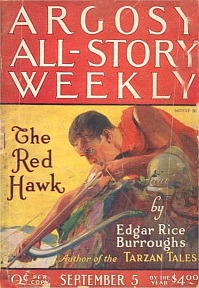
EVERYBODY OFF THE ARK
September 6: On this day in 1941, Argosy Weekly published the third and final installment of “The Quest of Tarzan.” Virgil Finley drew the cover for the issue. It didn’t illustrate the Tarzan story, it illustrated the E. Hoffman Price tale, “Faraway Loot.’
The story should not be confused with “Tarzan’s Quest,” but it often was and so was retitled “Tarzan and the Castaways” for book publication by Canaveral Press in 1965. The Ballantine paperback editions and a subsequent Canaveral reprint used the “Castaway” title.
The 100 word drabble for today. “Everybody Off the Ark,” was inspired by “The Quest of Tarzan,” aka “Tarzan and the Castaways.”
EVERYBODY OFF THE ARK
![]()
Patricia, an English woman said, “You saved the lions, the tigers, the orangutans, and the elephants. Why didn’t you save the snakes?”
“Elephants and lions are my friends. Orangutans are like family and tigers are as lions - colored differently. Histah the snake is my enemy. I only help friends.”
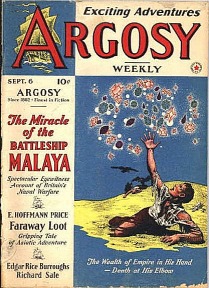
September 7: On this day in 1946, Edgar Rice Burroughs began writing a new Tarzan novel. His health was declining and he only wrote 15,000 words (82 typewritten pages.) The partial novel was finished years later by Joe Lansdale in 1995 and published by Dark Horse, a publisher better known for comic books. A comic adaption of the story was also released in four parts. As to be expected, some folks loved Lansdale’s work and some were highly critical, but as the old saying goes, “You can’t please everybody.”
Dark Horse published a leather bound hardcover first and a hardcover trade edition of the book. Ballantine Del-Ray published a paperback in 1995. "Tarzan The Lost Adventure"
The 100 word drabble for today, “Silent Jungle.” is the second paragraph from the book as rewritten by Lansdale. Lansdale changed and increased the verbiage in this passage. To compare the two versions side by side and read the publishing history and some book reviews, visit: https://www.erbzine.com/mag7/0733.html
SILENT JUNGLE
![]()
PASTRY
September 8: On this day in 1905, actor Henry Wilcoxon (Harry Frederick Wilcoxon) was born in the British West Indies. Wilcoxon was the leading man is several of Cecil B. DeMille’s films and even served as an associate producer with DeMille on a number of them.
In 1939 he appeared in “Tarzan Finds A Son,” with Maureen O’Sullivan, Johnny Weissmuller, and Johnny Sheffield. Wilcoxon played Mr. Sandee Sande. Film details are available at: https://www.erbzine.com/mag6/0620.html
His roles included Marc Antony in 1933’s “Cleopatra,” the vicar in “Mrs. Miniver,” Sir Lancelot in “A Connecticut Yankee in King Arthur’s Court,” and Bishop Fred Pickering in “Caddyshack.” He was the producer or associate producer for “Samson and Delilah,” “The Greatest Show on Earth,” “The Ten Commandments,” and “The Buccaneer.” He has a star on the Hollywood Walk of Fame.
The drabble for today is “Pastry,” and it was inspired by the plot of “Tarzan Finds A Son.” Interestingly enough in the film “Boy” is identified as the heir to the Greystoke fortunes.
PASTRY
![]()
Jane believed their evil lies, but Tarzan objected. The Lancings were captured by Zambeli tribesmen, known to mutilate and kill their captives. Tarzan brought elephants to the rescue.
Tarzan offered the Lancings Italian pastries and ordered
them from the jungle.
Mr. Lancing said, “We’ll take the child.”
Tarzan replied, “No! Leave the child. Take the cannoli!”
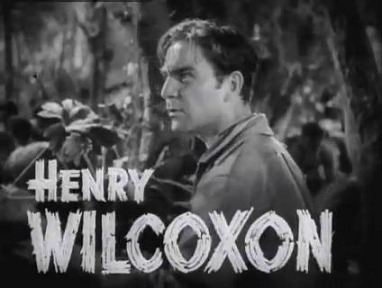
CALL FOR HELP!
September 9: On this day in 1899, actor Neil Hamilton, who played Harry Holt in 1932’s “Tarzan the Ape Man,” with Johnny Weissmuller and Maureen O’Sullivan, was born as James Neil Hamilton in Lynn Massachusetts.
Hamilton appeared in over 100 movies and television shows. His best remembered role was Commissioner James Gordon in all 120 episodes of the 1966 – 1968 Batman television series, not to be confused, though it often is, with the role of Perry White on “The Adventures of Superman, played by John Hamilton, no relation. Hamilton was respected as a true professional. Always on time, always knew his dialogue, and never missed a cue.
The drabble for today is “Call for Help!” – inspired by Neil Hamilton’s career.
CALL FOR HELP!
![]()
“Tarzan just knows when there’s trouble.’
“I’ve heard that yell. Is that a signal for help?”
“It’s his yell of victory, not mine to ask for help.
I don’t have a way to call him.”
“Ridiculous. Next time I work with a superhero, I’m
going to demand a signal. An ape-signal, perhaps, that I can flash in the
sky.”
“Wish for an ape-mobile while you’re at it.”
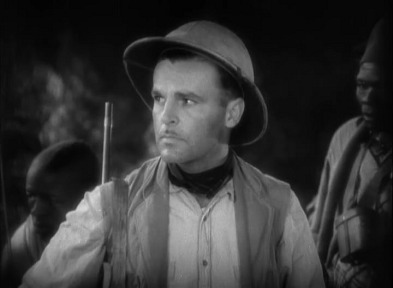
SWING HIGH
September 10: On this day in 1975, stage actress Jennifer Gambatese, who created the role of Jane in the Broadway production of “Tarzan.” Musical,” was born in Philadelphia, Pennsylvania.
Besides playing Jane, Jenn has also appeared in several stage productions including appearances as as Annie in “Annie Get Your Gun,” Maria in “The Sound of Music,” Carrie Pipperidge in “Carousel,” and Glinda in “Wicked.” She has several other stage credits, both on and off Broadway. We saw her in the national tour of “Wicked.” She was great. Jenn returns to Broadway as Miranda Hillard in “Doubtfire” on October 21, 2021.
Details and photographs about “Tarzan” are available at: https://www.erbzine.com/disney/
The New York Times review (2006.05.11) written by Ben Brantley of the play was largely critical of the production. He was particularly unkind to Jenn Gambatese. The 100 word drabble for today, “Swing High” is taken directly from that review. For whatever it’s worth, I thought that Brantley’s review completely missed the mark. As Tarzan would say “Kreegah, bundolo!’
Almost everybody swings in "Tarzan." Which is odd, since the show itself, to borrow from Duke Ellington's famous credo, definitely ain't got that swing.
SWING HIGH
![]()
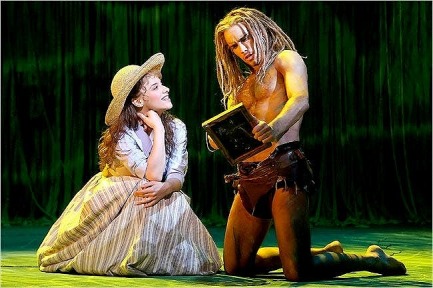
BEST TAKE
September 11: On this day in 1922, director Robert Frederick Day was born in Sheen, England. He directed numorous television episodes and his movie direction credits included “Tarzan the Magnificent,” “Tarzan’s Three Challenges,” “Tarzan and the Valley of Gold,” and “Tarzan and the Great River.” He also directed Ursula Andress in the Hammer production of “She” in 1965. His four Tarzan pictures ties him with Richard Thorpe. I believe that four Tarzan pictures is the most directed by anyone.
Details of all four of Day’s Tarzan films may be found at: https://www.erbzine.com/mag0/0013.html. Erbzine has several articles about the films, but this is a good place to start.
He was married to actress, Dorothy Provine for 42 years, from 1968 until her death in 2010. Dorothy Provine’s performance as a saloon singer in “The Great Race,” where she performed, “He Shouldn’t-A Oughtn’t-A Swang On Me,” is a true classic.
The drabble for today is “Best Take,” and it was inspired by Robert Day and the film, “Tarzan the Magnificent.”
BEST TAKE
![]()
‘You were magnificent. Your acting skill exceeded expectations. Your face was expressive, you movements were choreographed. I loved the way your face turned red. Were you holding your breath?”
Scott growled, “I was choking. The damn snake was killing
me.”
“Stop complaining. Remember what I told you. The first
time the animal gets the scene right, that’s the one we use and the python
nailed the take. Your next scene is with a crocodile, don’t let it upstage
you.”
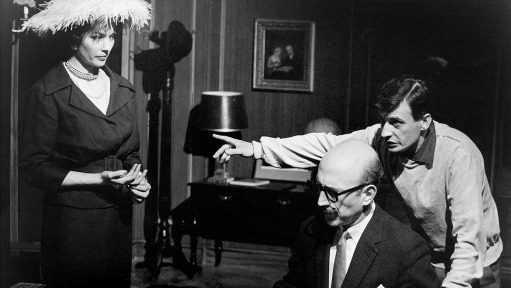
VACATION STORY
September 12: On this day in 1924, Edgar Rice Burroughs replied to a fan letter from Maurice B. Gardner, who went on to write the “Bantan,” Tarzan pastiches or tributes – depending on your assessment of the books. I have all of them, but I confess, I’ve only managed to read two completely. Gardner also authored several articles about Burroughs’s work and was a founding member of the Burroughs Bibliophiles.
Burroughs uses the fan letter to hype his new story, “The Bandit of Hell’s Bend,” which was scheduled to appear on the newsstands the next day.
The entire letter by Burroughs is at: https://www.erbzine.com/mag7/240912.jpg
The drabble for today, “Vacation Story,” is a 100 word excerpt from Burroughs’s letter to Gardner.
VACATION STORY
![]()
I hope you like the Bandit of Hell’s Bend, one of my vacation stories.”
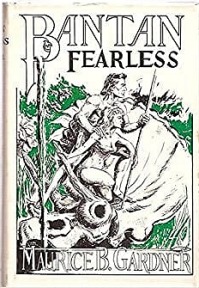
PROFESSIONAL HONOR
September 13: On this day in 1924. Argosy All-Story Weekly, a Munsey magazine published the first installment of six parts of “The Bandit of Hell’s Bend.” Modest Stein drew the cover illustration. Roger B. Morrison drew one pen and ink illustration for the interior of each of the six installments.
When A. C. McClurg published the first edition of the book on June 4, 1925, they used the same Modest Stein illustration as Argosy All-Story.
The issue contained the story, “The Conquering Heart,” by Max Brand, along with another 19 stories or story installments. In a stroke of remarkable enlightenment for the times, ten of the stories had female authors. The one writer I’ll mention here is Beatrice Vandergrift Ashton, who wrote 84 stories for the pulps for Argosy All-Story Weekly over a five year period 1922-1928. Her work, mostly romances, has almost entirely vanished into time.
Publishing details, illustrations and other ephemera about the novel, “The Bandit of Hell’s Bend,” is available at: https://www.erbzine.com/mag7/0771.html
The drabble for today, “Professional Honor,” was inspired by “The Bandit of Hell’s Bend.”
PROFESSIONAL HONOR
![]()
Diana Henders the leaned out the stagecoach window.
“There’s no payroll, cash, or gold, you idjit. This stage left Cottonwood Gulch. Money comes in, but it never goes out.”
“I’ll check for myself.”
“A proper bandit should wear a proper mask.”
“My mask?”
“It’s a dirty bar rag, not a mask, probably stolen
from the saloon? If I’m to be robbed, I’ll be robbed by a proper bandit,
not some rag-faced guttersnipe.”
The bandit hung his head, holstered his gun, and road
away.”
Diana shouted, “A man should take more pride in his
work.”
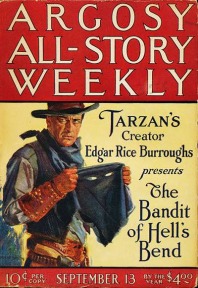
RARE GENIUS
September 14: On this day in 1936, Irving Thalberg, who was the head of production at Metro-Goldwyn-Mayer and instrumental in procuring the Tarzan movie rights for the studio died at age 37 in his Santa Monica home – only ten days after filming was concluded on “Tarzan Escapes.”
A month later, John Buckler, who played the villain Captain Fry, was killed in a traffic accident on Halloween. Herbert Mundin, who’d played Rawlins was killed in another car wreck shortly thereafter.
Details about the cursed film, “Tarzan Escapes,” are at: https://www.erbzine.com/mag63/6396.html
Returning to Irving Thalberg, his ideas, insight, and imaginations helped create numerous film classics. The Irving G. Thalberg award is awarded when appropriate by the Academy of Motion Picture Arts and Sciences to producers for lifetime achievement.
I won‘t even try to list all of Thalberg’s work, but will mention that he was the producer for “Tarzan the Ape Man” in 1932.
The drabble for today is “Rare Genius,” and it was written by Thalberg’s competitor, Darryl F. Zanuck, the founder of 20th Century Fox.
RARE GENIUS
![]()
